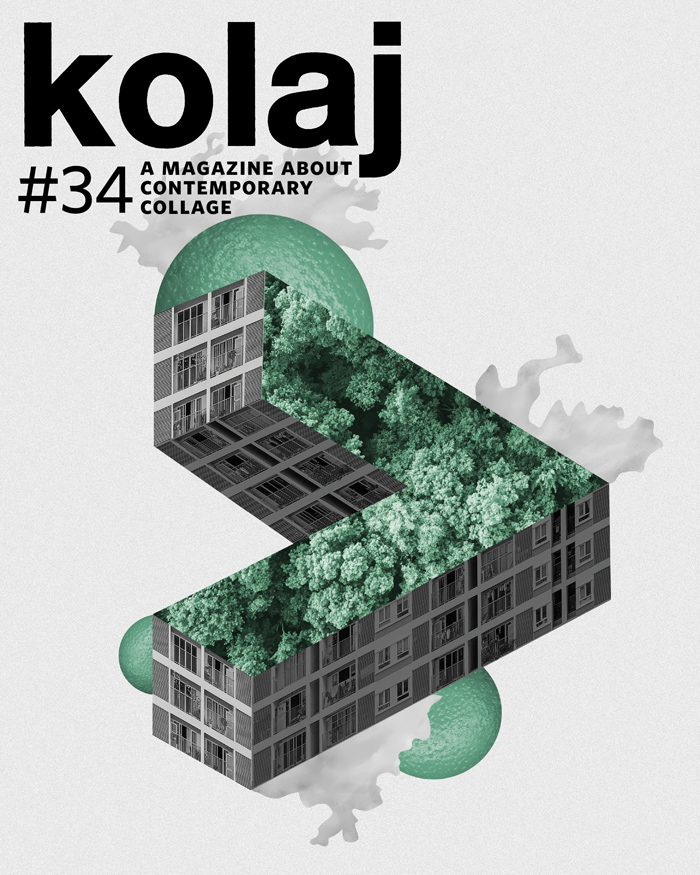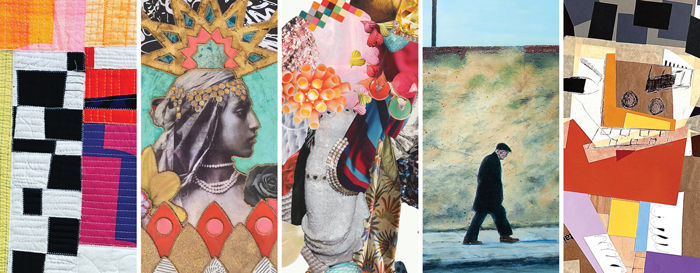
SUBSCRIBE OR ORDER A COPY
INSIDE THE ISSUE
“Artists working with collage are in the business of taking risks and stirring trouble, as it’s a form conducive to critique” writes Natasha Chuk who reports about how Brooklyn, New York artist Heather Olker uses collage to critique fashion advertising
Cherie Rahkola reports on Canadian artists Kal Honey & Kim-Lee Kho’s Virtual Collage Jam. “This talented husband and wife team has given generously of their time to host a free forum for like-minded collage artists from all backgrounds to create and communicate.”
We preview the collage exhibition: “Allegories, Renditions, and A Small Nation of Women” taking place this fall at Yale Divinity School in New Haven, Connecticut, USA and speak to Curators Khaleelah I. L. Harris and Teri Henderson.
“For Black women, the Christian project and the opportunity to emulate that prototypical woman moralized them, feminized them, and helped them become ‘American citizens’,” said Harris
In our roundup of collage news: Self-taught artist Vakseen opened the first Black-owned brick-and-mortar art space in North Hollywood, California in September. At Kolaj Institute, G.E. Vogt and Christopher Kurts led a Politics in Collage Residency with guest speakers Ginger Sedlarova, John J Heartfield, Wendy Parker, Teri Henderson, Liucija Dervinyte. Collage artists Ginger Sedlarova and Valerie Arntzen have teamed up with artists David MacLean and Ali Ledgerwood on a project to acknowledge the contributions of front-line workers—nurses, doctors, grocery and café workers—during the COVID-19 pandemic. Collage artist Amy Zerner has published her tarot deck. The Wild Goddess Oracle: Divination and Ritual for Living an Empowered Life features 52 illustrated cards featuring Zerner’s collage, and a 144-page guidebook by her husband, bestselling author Monte Farber
A self-described “art engineer”, California-born, New York City-based collage artist Luis Martin was looking for a way to create community around collage and curiosity. In “Building Connections & Forging Community,” we consider his Collage Dream Collage Kits. Martin’s collage, Facing God from his “Mirror of 100 Faces” series, is on the back cover
Belarusian collagist Katia Burak uses collage to explore ideas about reality and illusion. Her collage, Living Space, is on the cover of Kolaj #34 and inside the issue Burak unpacks her thinking on the topic.
“What if I use collage to create an illusion? What if I create illusionary spaces with it? Impossible spaces defined by textures of real life? What if I enclose a piece of reality itself in an illusion? It would be more than a simple oxymoron. It becomes an intellectual performance, a dialog between the creation and the observer.”
Irish artist Anthony D Kelly & Warsaw-based collagist Marta Janik report on their visit to County Offaly, Ireland for the opening of the international collage exhibition, “Empty Columns Are a Place to Dream” at the 53rd Annual Birr Vintage & Arts Week. The project recently won a National Heritage Award in Ireland and travels to the Knoxville Museum of Art in Tennessee in November.
Steven M. Specht, Ph.D. unpacks the psychology of the creative process. In “Chaos, Complexity, And Collage,” he writes, “Despite extensive efforts by a number of psychological researchers over the decades, the cognitive complexities of what could be called ‘the creative process’ have remained somewhat elusive.”
Todd Bartel asks, “Are Readymades Uncollages?” By reflecting on the work of Marcel Duchamp, Pablo Picasso, and Jack Massey, Bartel expands our understanding of collage.

ARTIST PORTFOLIOS
Jen Broemel
Indianapolis, Indiana, USA
I see collage as putting together scraps of things. To make something new, to repurpose, to reinvent through material, process and creating meaning in the moment.
Johannes Boekhoudt
Rockwall, Texas, USA
The artist builds the abstract scene with cross strokes of increasing color and density that culminate in a flurry of kineticism.
Jill Ricci
Asbury Park, New Jersey, USA
By combining elements of advertising ephemera, hand-stenciled papers, global motifs, design and abstraction, I find a way to create work that feels both ancient and modern.
Brian Palm
Dublin, Ireland
This theme of disquietude is reinforced by the repeated depiction of an abandoned tricycle, left in the street forgotten after play was interrupted.
Angela Piehl
Milwaukee, Wisconsin, USA
I’m dealing with sensory information that is simultaneously seductive and repulsive, as well as interpreting emotions relevant to both the sublime and the abject aspects of my particular culture and time in history.
